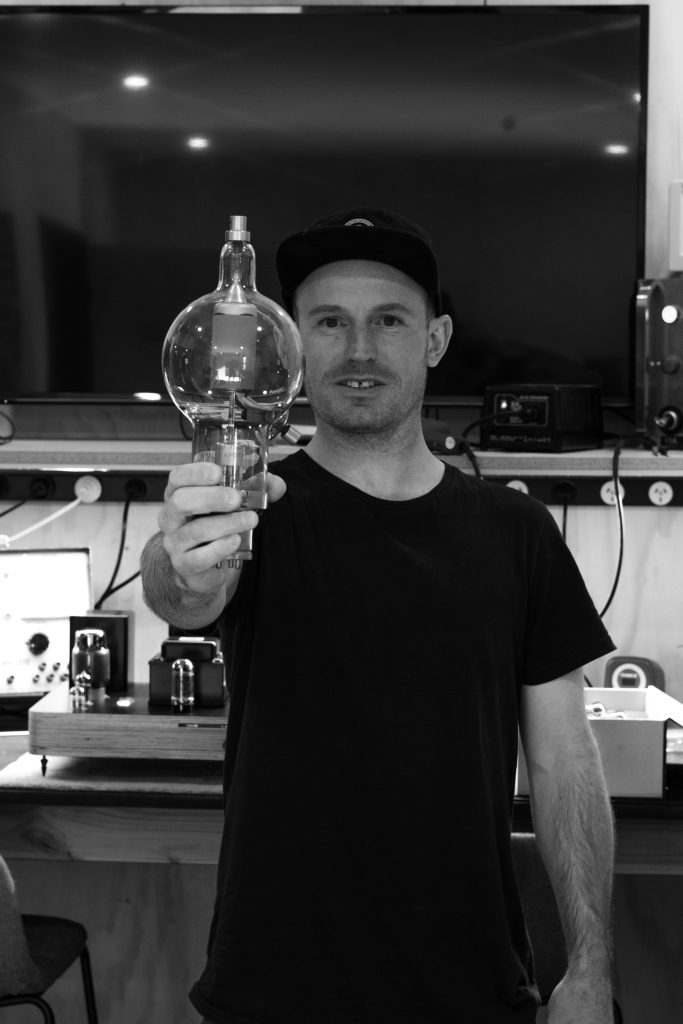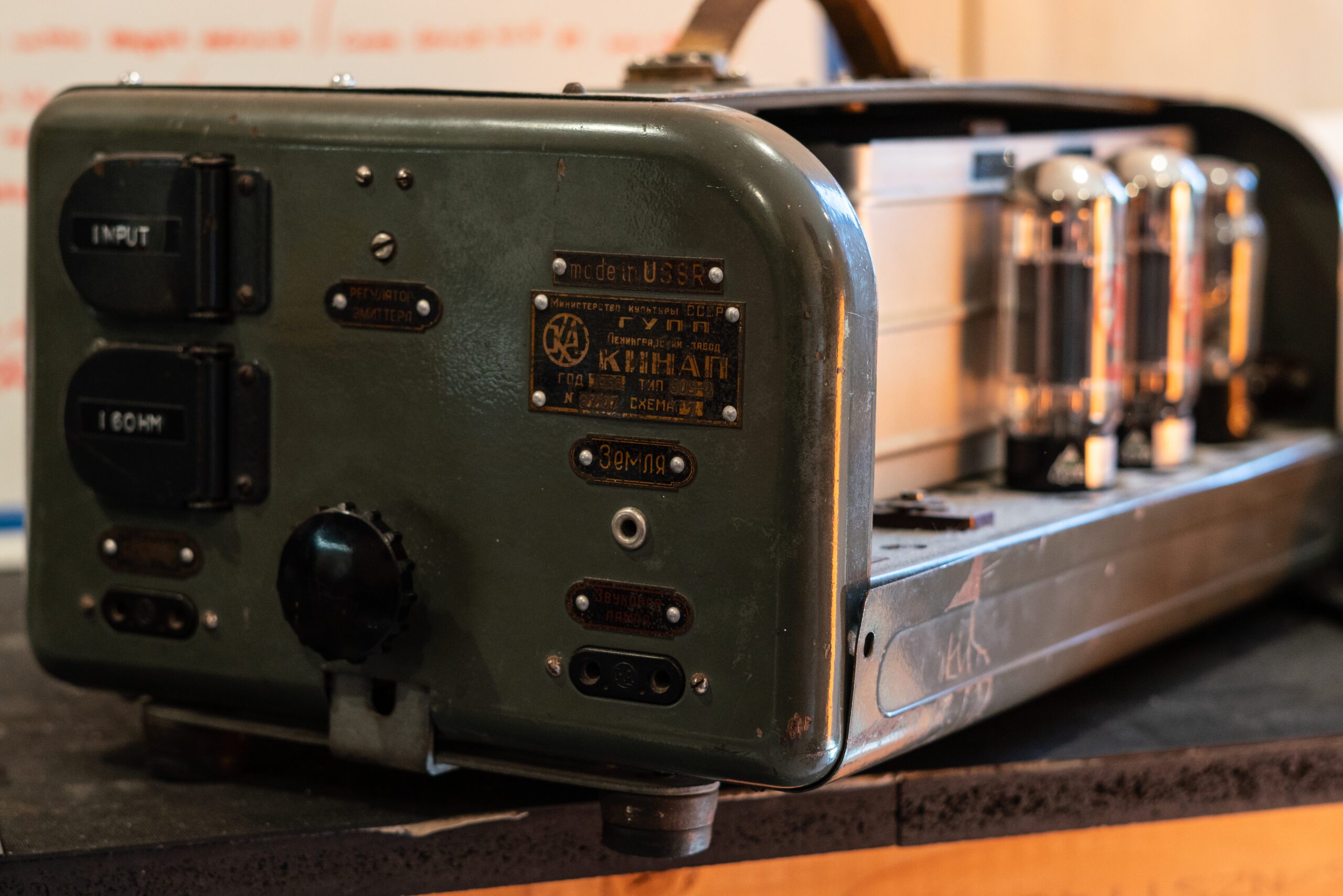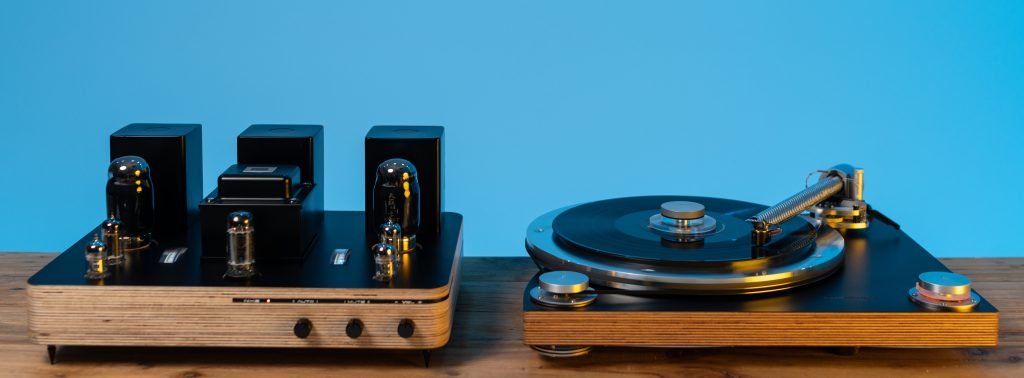Harry Dawson’s Nixie amps have a heart of glass.
SOMETIMES FUNCTIONALITY TRUMPS BEAUTY. SOMETIMES HISTORY DOES TOO. BUT SOMETIMES BEAUTY WINS. EXHIBIT A: THE VALVE AMPLIFIER.

The garage-slash-workshop in Harry Dawson’s garage is, in square meterage, as big as his house. It has two spaces: a “dirty room” and a “clean room”. Much of the larger, dirtier one is taken up by a 2.7 by 1.4-metre Proteus CNC machine. The smaller space is a mad scientist’s dream crammed with wondrous devices, many of them hand-made by Harry himself. In one corner, there’s a Variac-style variable autotransformer made from a modified Philips X-ray machine; in another sits a vacuum desoldering pump. The workbench hosts a hot-air rework station, a home-made capacitor tester and what I swear is the very Pioneer SX-650 stereo receiver from my pre-1988 childhood bedroom, complete with a ‘loudness’ switch, whatever that was for.
Harry makes beautiful boutique tube amplifiers. It’s a technology that used to be everywhere. A valve audio amplifier uses vacuum tubes to amplify sound. Perfected by the American inventor Lee De Forest in 1907, the tubes in question are glass-encased triodes consisting of three electrodes: an outer anode plate, a central cathode and a control grid, which is attached to a high voltage supply. A heating element warms up the cathode, which causes the electrons to stream towards the anode. Like a tap (hence “valve”), the grid then moderates this flow.
If this is all a bit ‘because, physics’ for you, don’t worry. The main thing to understand is that when the science pops off and the electrons start to jiggle, the tubes light up. They glow with a warm light that diffuses through the curved glass like breath on an ember, like a lone French horn, like a neon heart. And they sound just as good.
Early applications of the valve amplifier included long distance telephone communications, radio broadcasting and shepherding the motion picture industry out of the silent era. By the 1970s, however, valves had largely given way to solid state amplifiers, which use silicone transistors in lieu of tubes. They were cheaper, louder and more durable. But the poetry was lost, and now, like vinyl records and words printed on paper, tubes are making a comeback.|
Harry trades under the name Nixie, which comes from the Nixie tube. Short for ‘Numerical Indicator experimental No.1’, Nixie was an early digital numerical display system. Number-shaped wire meshed cathodes were set inside blown-glass tubes filled with a neon-based gas mixture. A spot of power, and presto, the numbers lit up. They were used in many of the places you would associate digital number displays with today: frequency counters, calculators, voltmeters.
(Nerd intel: Nixies are highly sought-after collectors’ items, and none other than Apple co-founder Steve “the Woz” Wozniak has a watch made from Nixie tubes).

The Cold War-Soviets were especially fond of Nixie displays and other vacuum tube technologies, putting them in their tanks, submarines and MiG-25 fighter jets. This was because, unlike solid-state electronics, vacuum technology isn’t knocked out by the electromagnetic pulses associated with nuclear explosions. Harry has a circa-1956 Russian cinema amp in his garage, which he upgraded with an input for an electric guitar. It is possibly the coolest object I have ever seen.

Originally from Northumberland, Harry now lives in Luggate, a small township perched on the edge of the highway that runs between Wānaka and Cromwell, with his wife Masae and their two young children. How he ended up there is a tale common to the region. He was planning to travel the world, with Aotearoa as his first stop. It was getting on for winter and a friend was living in Wānaka, so he came down to check it out. After that, he says, “I had no interest in going anywhere else. It was all here. I just never left.”
Harry did an electro-technical apprenticeship after he left school. “I would have really liked to do electronics, but there was nothing available. The careers advisor said I should do a trade instead.” He now works full time as an electrician, but his passion for electronics never stopped percolating.
Nixie started with a story his dad told him, about how Harry’s grandfather had built a television from tubes back in the day. “It would have been a kitset – one of those things you found in the back of a newspaper and sent away for. My dad told me it was made all from valves, I thought that was super cool.” Much later, he came across a tube guitar amp at a garage sale run by the Holy Family primary school in Wānaka. Harry plays a bit of guitar, and it was only $10, so he bit. “It didn’t work. I took it apart, pulled everything out, bought new components, did some point-to-point wiring, sand-blasted the chassis and made it beautiful.” He sold it for $500.
Meanwhile, Harry decided to have a crack at grandpa’s hobby, and ordered some kits of his own. “I started out making kitset amplifiers and assembling them. I really enjoyed following the schematics. You wire it up, make a nice pretty job of the wiring, turn it up, and see if it goes bang.” You can see the appeal. It’s old- school fun straight out of The Dangerous Book for Boys.

But do vacuum tube amps really sound better? That’s a complicated question. On paper, solid state should be superior. Tubes cause harmonic distortion, which you would think wouldn’t sound good, but it does. According to Harry, this is because perfection is “not natural to our ear.” Audiophiles, sound engineers and musicians, guitarists in particular, are often partial to tubes. A bit of complexity sweetens the sonic mix, the way rain sounds better on a tin roof, or how the gentle crackling of the needle makes a weathered LP superior to Spotify. (Google knows this. When I type in “solid state amplifiers”, the autocomplete adds “that sound like tubes”.)
While Harry enjoyed the kitset projects, he soon noticed their shortcomings. “The components were cheap, that’s why they are so affordable. I decided to take it up a notch,” he remembers. He found a schematic for a vacuum tube amp in a Japanese DIY magazine and set about ordering parts. He started to source expensive transformers from Japan – as in one transformer cost more than a whole kit expensive – along with potentiometers, switches and sockets. He soon had the internals sorted, but there was the matter of the chassis. As Harry explains, “I had made drawings, but I realised I needed to get it in CAD [Computer Aided Design] format. I hired a backpacker to take my drawings and put them into CAD. I then sent them to Farra Engineering in Dunedin, and they would send me back my parts.”
Effective, but not super-efficient, so to speed the process Harry learned to do CAD himself; he bought a small 600 x 600mm CNC router and DIY’ed the whole thing from start to finish. “I could wake up in the morning, put the kettle on, do a drawing, plot the tool paths, plug it all into the machine, and by the end of the day have working parts.” Oh, and he also taught himself to do printed circuit board design.
But the heart and soul of the whole thing is the tubes. They are still manufactured in places like Slovakia, Russia, China, the US, Germany and Japan, though Harry notes that the “real fanatics” prefer to get their hands on NOS, or New Old Stock – original products from the time that were never sold or used, preferably still in their packaging. It’s hard to come by, and expensive. NOS tubes go for thousands. Harry didn’t get his hands on any NOS, but he did hit paydirt in the form of Bannockburn resident Bruce McMillan, a retired IT professional who just happened to be the guy who installed Dunedin’s first-ever computer, a punch card-driven ICT 1301, at Cadbury Fry Hudson in 1963. He had a garage full of tubes he was happy to part with.
Harry finished his first Nixie in about 2016. He started out just selling to mates but can see it growing now, in part thanks to the accelerating revival of records and turntables. They are not cheap, nor should they be. Each one takes about 135 hours to make, which, around work and family, means “weekend after weekend” in the workshop. But when you see the finished product, you understand. It’s art as much as technology. Turn up the volume. When the sound moves behind glass, it glows.
WORDS: LAURA WILLIAMSON
PHOTOS (except where noted): JASON BEACHAM

